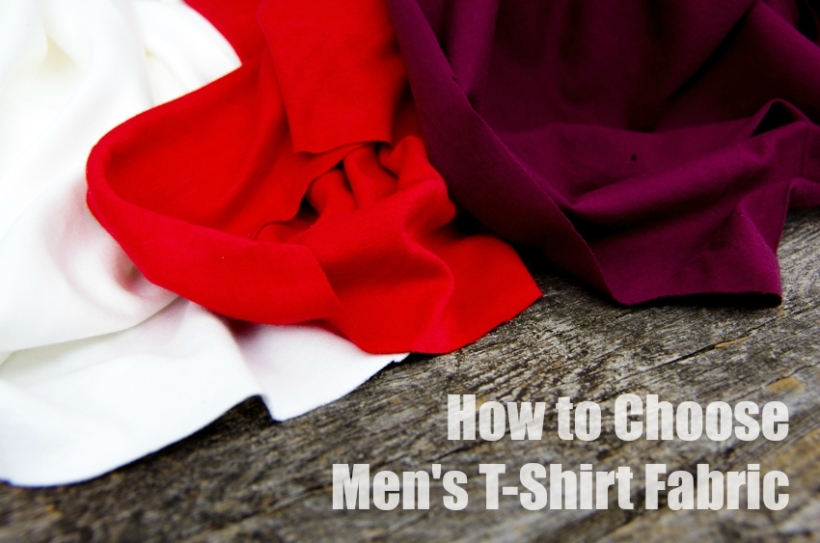
Choosing the perfect fabric is the most difficult aspect of sewing a men’s t-shirt! This guide will help to demystify menswear appropriate knits so that you can start the sewing confident that you will end up with a classic and flattering T-shirt.
What makes a t-shirt knit masculine?
To many people, the answer to the above question would be easy – they would say that the knit must be 100% cotton and of medium weight. As you may have already discovered, it can be very difficult to find such a fabric at your local fabric store! I am here to argue that you can make a very manly t-shirt with all manner of knits. Let me prove this to you by showing you some big brand store-bought examples ranging from basic cotton interlock to blended fabrics completely void of cotton!
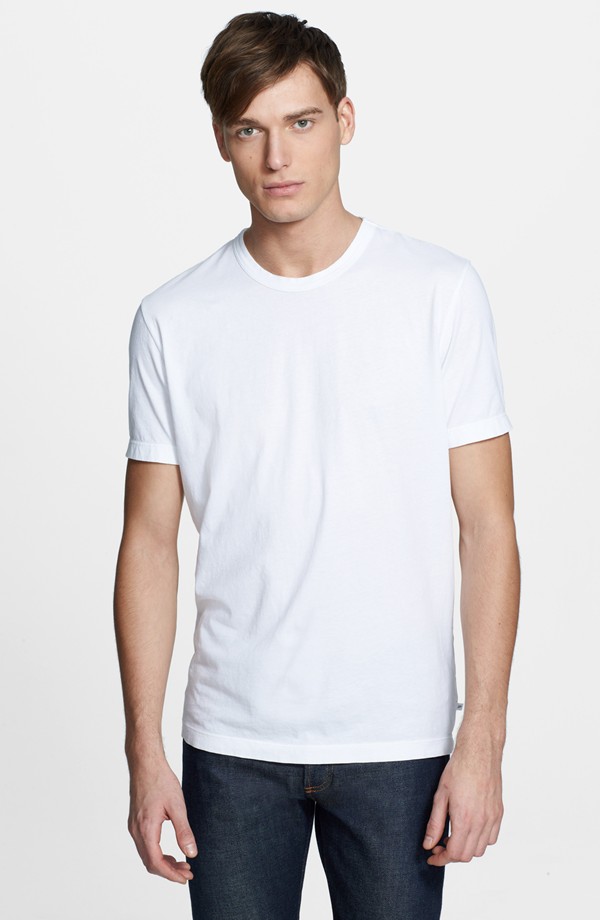
100% Combed Cotton Interlock T-Shirt from Nordstrom – this is a classic choice of fabric that will create a great ‘basic tee’.

100% Washed/Broken-In Cotton Jersey T-Shirt from J. Crew – this is a very modern and comfortable choice of fabric that will result in a very casual, drapey t-shirt.
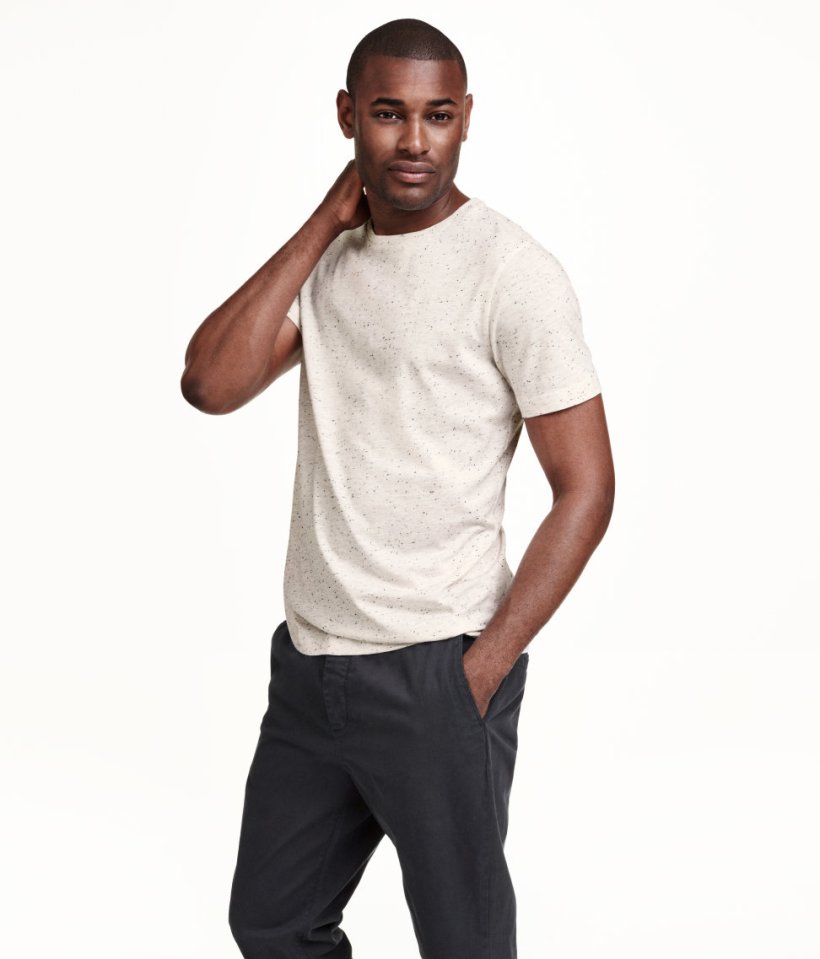
99% Cotton, 1% Polyester Jersey T-Shirt from H&M – polyester blends are very commonly found in graphic tees or event tees. A blended fabric can include a far higher percentage of poly than this example but it is important to keep in mind that this will result in a ‘sportier’ shirt, sweat wicking shirt best suited for the gym. A small polyester content will often result in a t-shirt that doesn’t wrinkle when it comes out of the dryer or out of the dresser drawer!
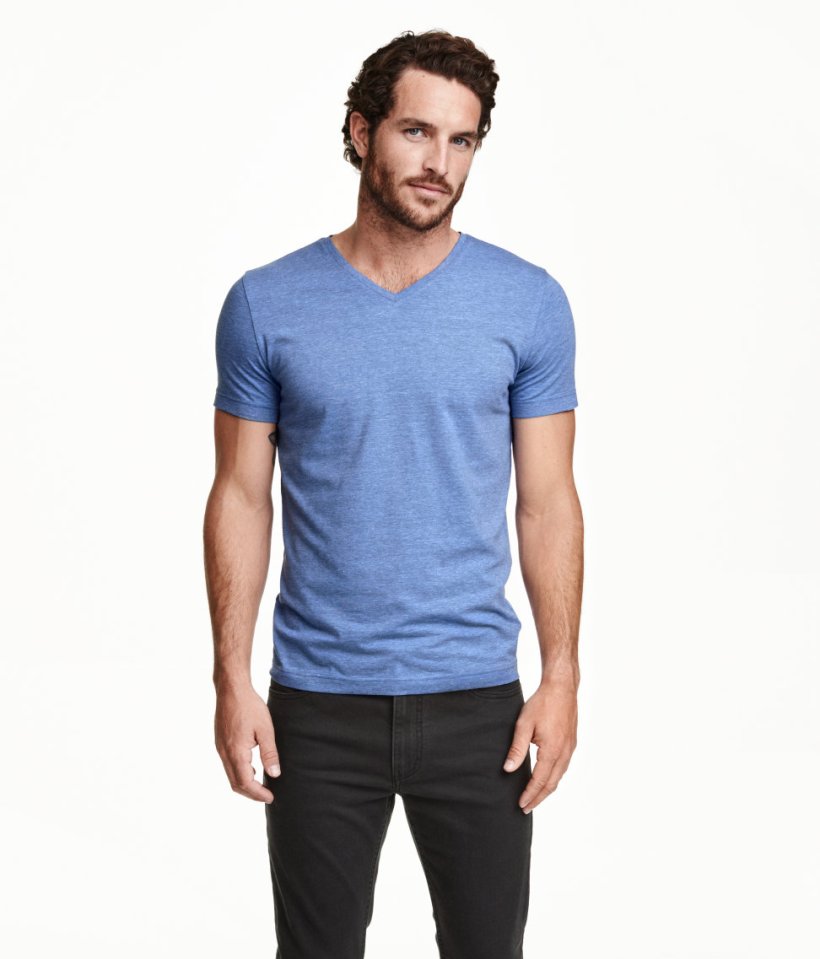
95% Cotton, 5% Spandex (i.e. Elastane) Jersey T-Shirt from H&M – a fabric with spandex content is best suited for tight fitting shirts that feature areas of negative ease (notice how the shoulders, chest and sleeves in the above example are skin tight). Spandex content will often result in a heavier and more drapey fabric so it will cling to the body in an unflattering way if it is used with a loose fitting t-shirt design.
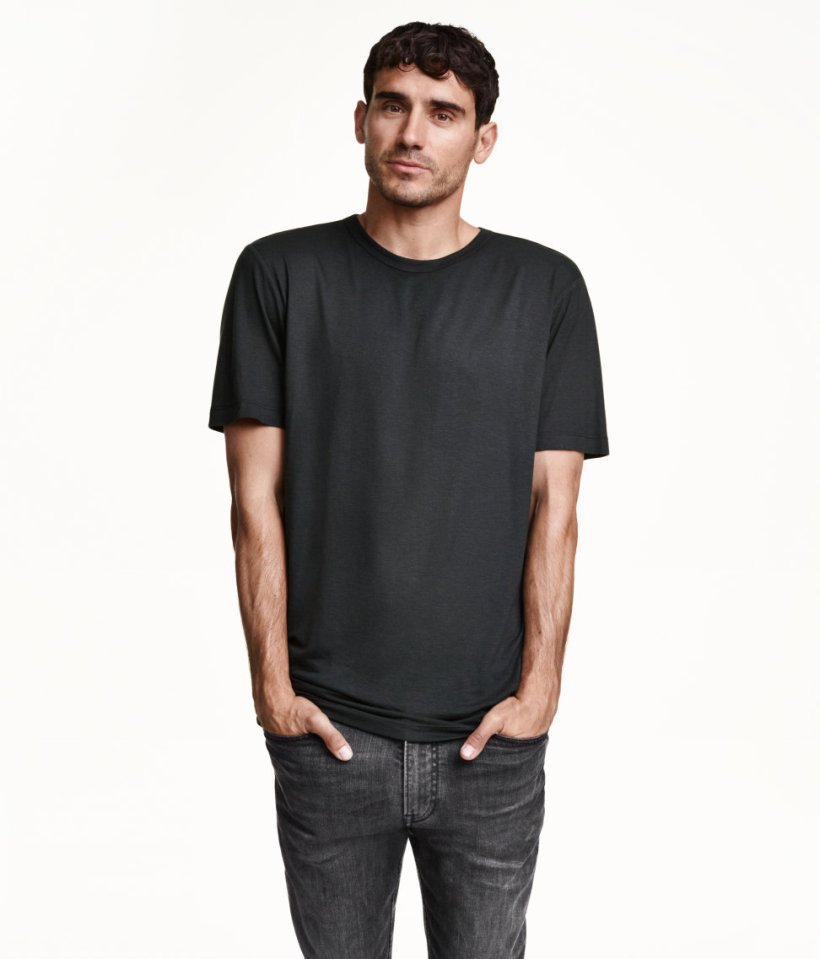
85% Viscose (i.e. Rayon), 15% Wool Jersey T-Shirt from H&M – this example illustrates how fun it can be to experiment with fiber content when sewing t-shirts! If you are into hiking and camping you might be interested to make a t-shirt ‘base layer’ out of Merino wool. It isn’t difficult to find Merino wool yardage and the resulting t-shirt will cost FAR less than fancy base layer garments from outdoor stores!
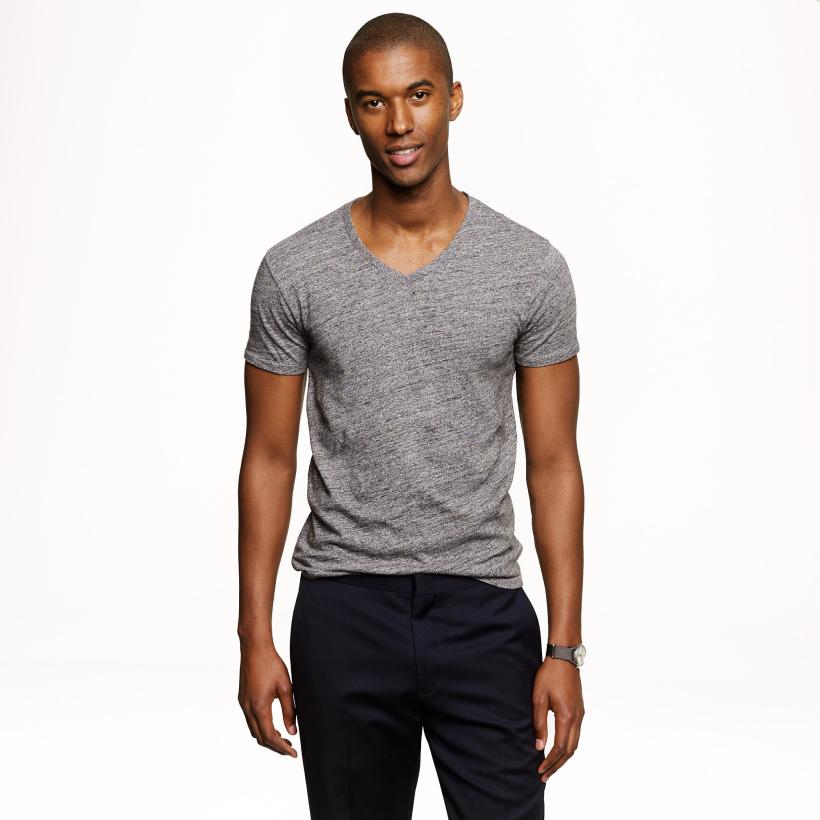
100% Slub Cotton Jersey T-shirt from J.Crew – It can be fund to experiment with textures when choosing t-shirt knits. A slubbed knit can look very rugged and masculine. I find that if a fabric is slubbed and heathered and fairly light weight, it will result in a t-shirt that looks attractively reminiscent of a cowboy’s undershirt ;).
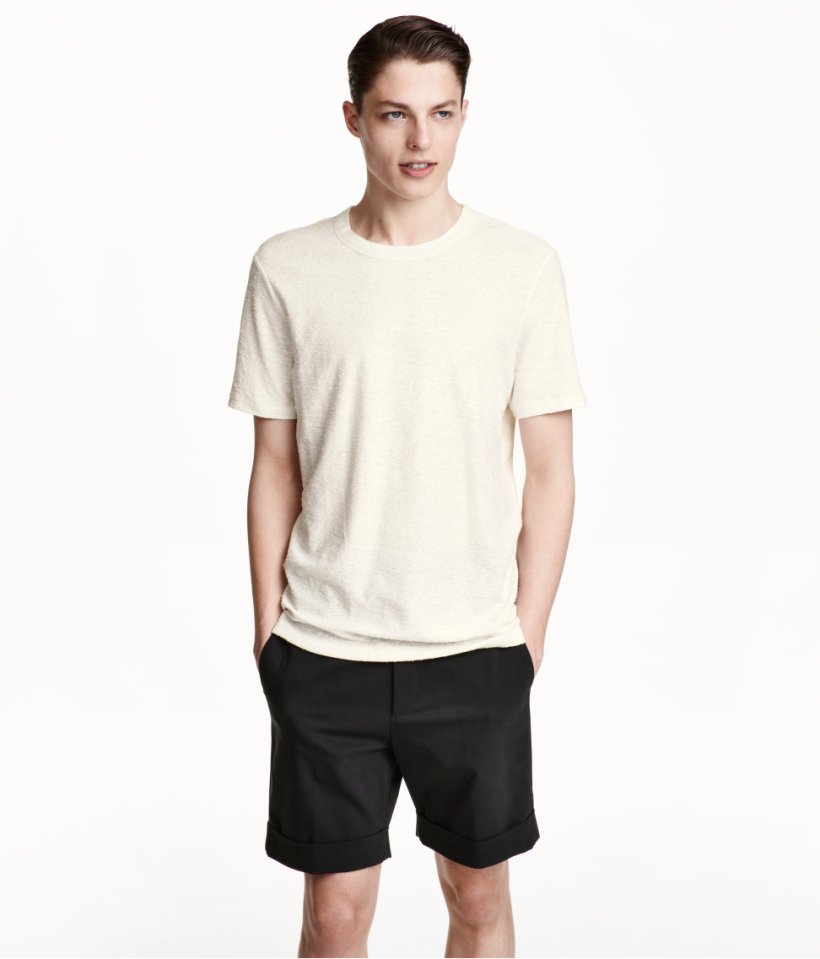
85% Cotton, 15% Linen Jersey T-Shirt from H&M – this is another great example of a creative blend of fibres. You can also look for Cotton/Rayon knits (quite drapey) and Cotton/Bamboo knits (very soft and smooth) when choosing menswear t-shirt fabrics!
As you can see, most of these shirts feature medium weight fabrics with little drape and minimal stretch. It is interesting to note that the only shirt containing spandex content features a much tighter fit than the other shirts. Since spandex content is becoming an increasingly common element in knit fabrics, it is good to know that a masculine t-shirt can still be produced with the spandex-laden fabrics found all throughout fabric stores.
Aside from fabric content, it is important to note the style of knit. An interlock knit is stiffer and has less drape than a jersey knit. I find that if I am in doubt about the suitability of a fabric for menswear (especially if I am choosing a printed fabric), I will err on the side of caution by using an interlock rather than a jersey.
Check your closet!
So now that we’ve determined that there is a surprisingly large range of acceptable fabric types, we must narrow things down by keeping the prospective wearer’s preferences in mind! The easiest way to do this is to open up the recipient’s closet and look at the t-shirts that are already there. Are they mostly of medium weight? What do the fabric content labels say? Do many feature unusual textures and graphics? Are there a broad selection of styles or does the person favor one type of fit?
Here are Matt’s favorite t-shirts as an example along with why they are his favorite:
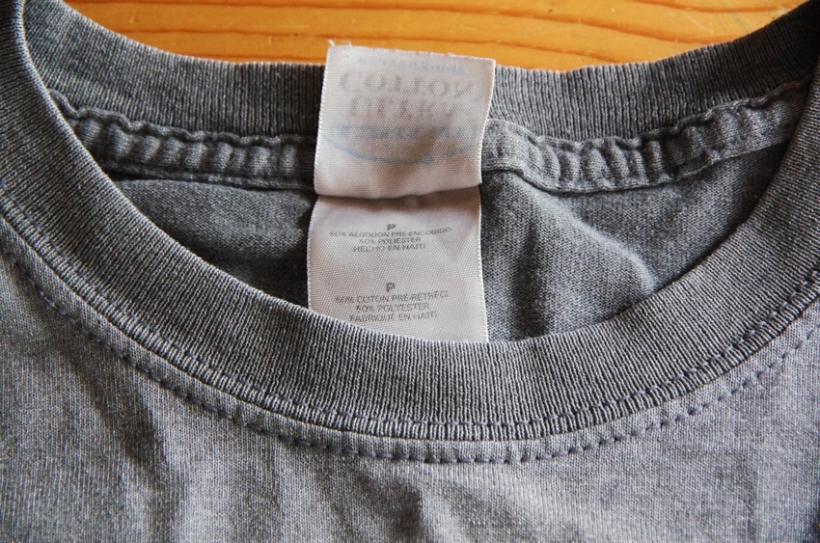
He has had this free event t-shirt for MANY years and it is only just now beginning to show wear. He loves that the hems do not fold up and wrinkle as many of his t-shirts with less polyester content tend to do. The weight is quite heavy compared to some of his more ‘fashionable’ t-shirts but the polyester adds a bit of fluidity to the fabric so it doesn’t look too crisp and so that it forms to his body just enough to be flattering.
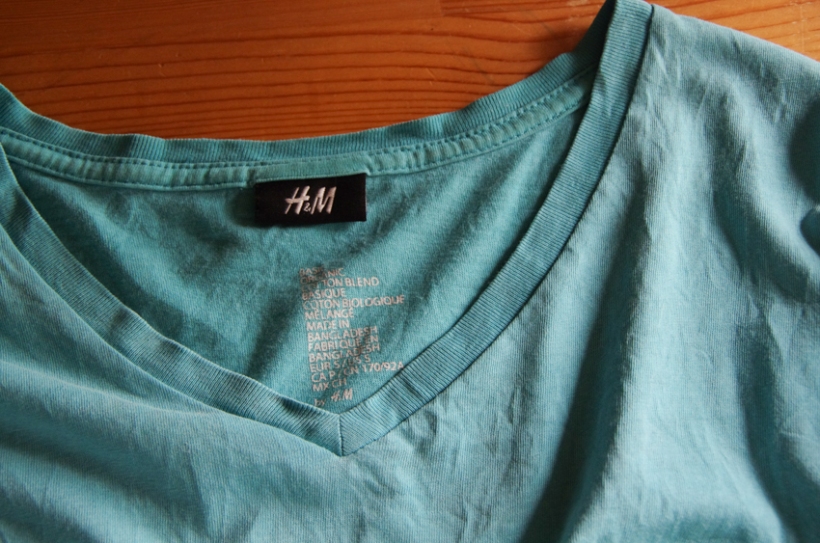
He wears these v-neck H&M t-shirts often because he likes the fit of the sleeves and the v-neck (and the selection of bright colors). He wishes that the fabric were slightly heavier because they tend to show a bit of nipple!
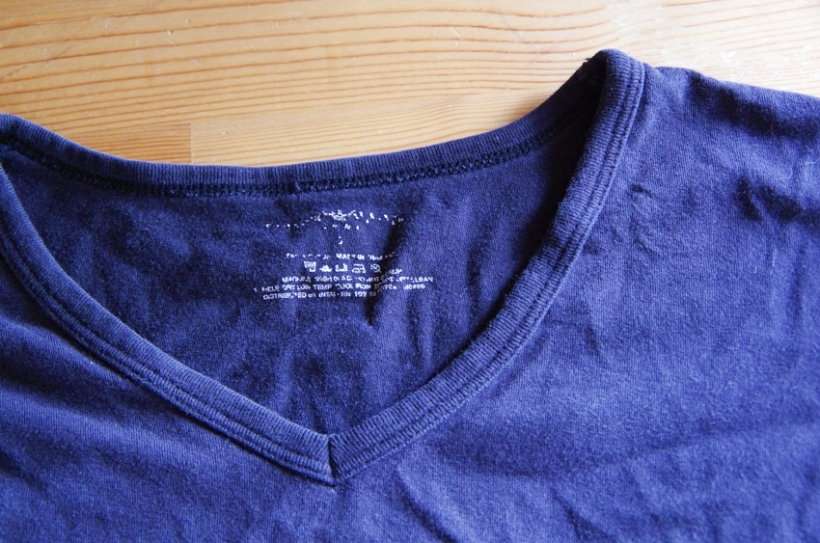
While he wears these Armani t-shirts often, their tendency to wrinkle bothers Matt. The sleeves are always folding up and the narrow neck binding makes them look a bit misshapen. These shirts were designed as undershirts rather than t-shirts and the fabric is even more light weight than the H&M t-shirts due to this. Matt requires all of his clothes to be suitable for mulitple purposes so a thin t-shirt meant ONLY for use under button-ups does not suit his wardrobe.
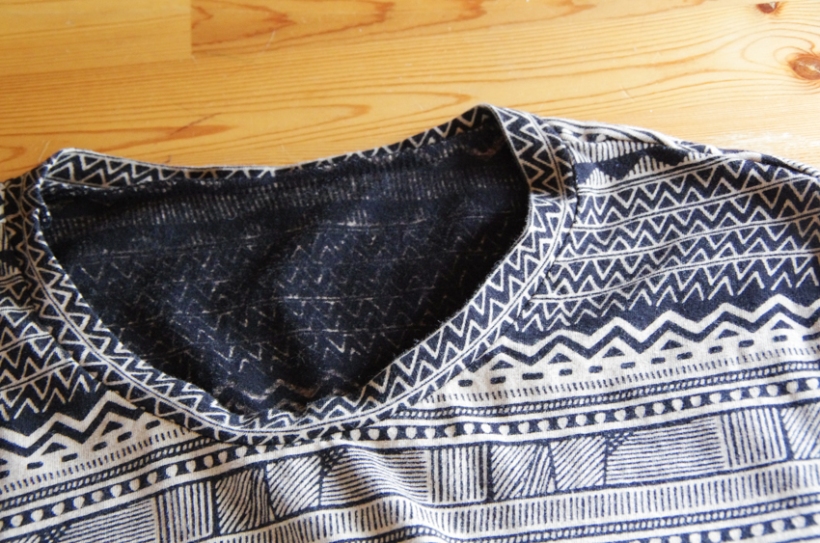
This is Matt’s favorite Strath Tee! It is made using a Girl Charlee knit that is no longer available. I think it may be a blended cotton/poly knit. It doesn’t contain very much stretch and it is of light to medium weight (a touch heavier than the H&M tees). Matt gets compliments on the print CONSTANTLY and he feels really confident in this shirt. I shortened the sleeve length considerably to be the most flattering length for Matt (I will talk about this more in the next sew-along post!). I think that the print suits the crew neck style and might be a touch more wild than Matt prefers if it were on a v-neck shirt.
How thick? How stretchy?
I like to err on the side of thick and not very stretchy but picking fabrics with different properties (thick and quite stretchy, thin and not very stretchy) is still a possibility as we saw in the ready to wear shirts above! Here are the fabrics that I picked for the Strath Tee sew-along. They include:
A 100% Cotton Interlock of medium weight with matching 1X1 ribbing…
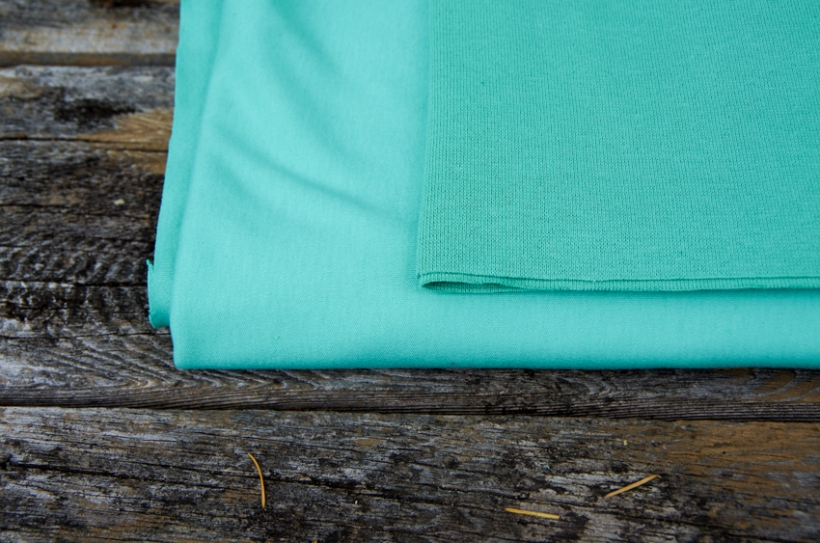
A 100% Cotton Interlock of medium weight without ribbing…
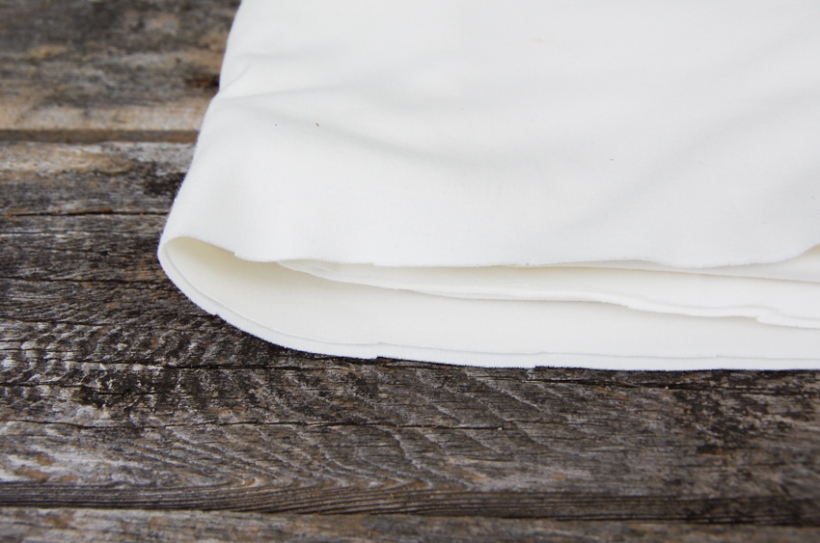
A 100% Cotton Jersey of light weight (note that there is no spandex content so this fabric does not contain too much drape)…
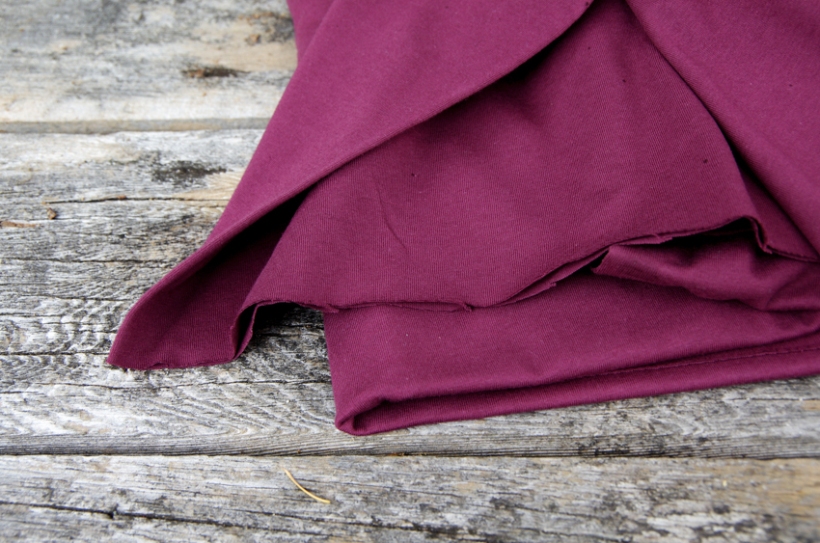
A cotton/bamboo blend jersey of light to medium weight (sorry, I don’t know the percentages!)…
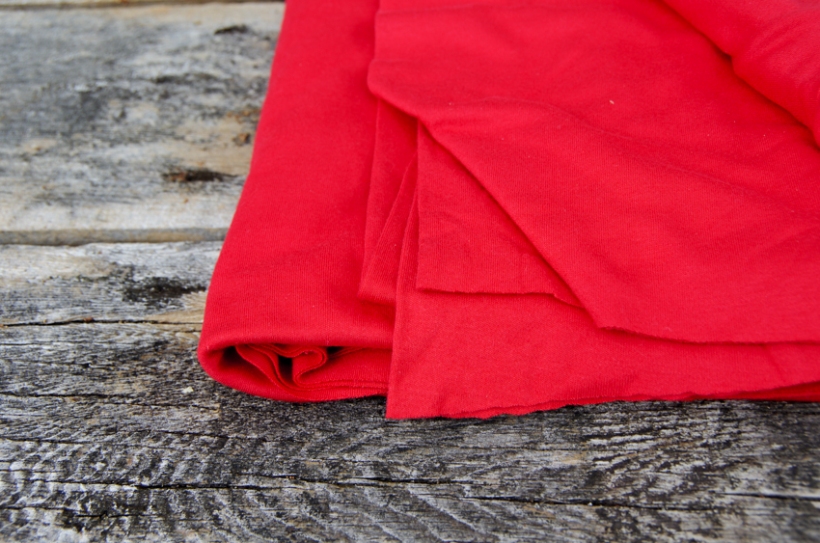
You can sort of see their relative thicknesses here (the teal and white knits are the same fabric in different colours so I only photographed the white interlock):
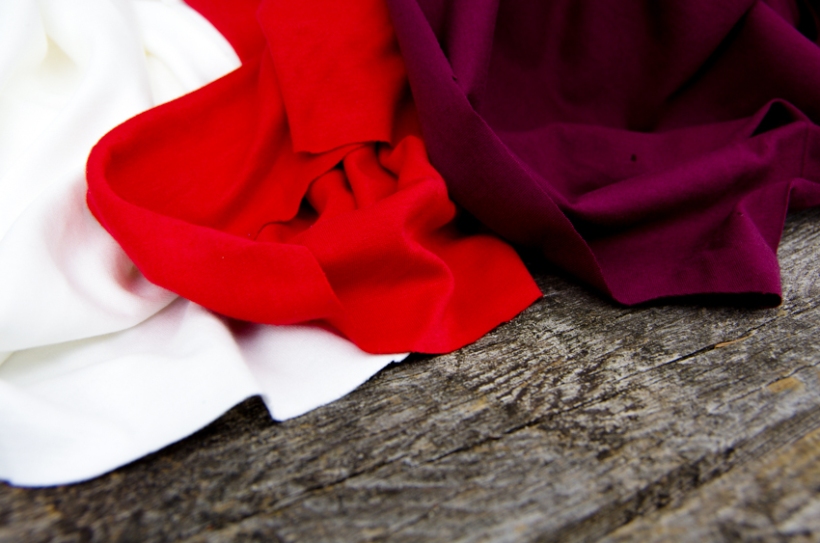
And here are their stretch capabilities:
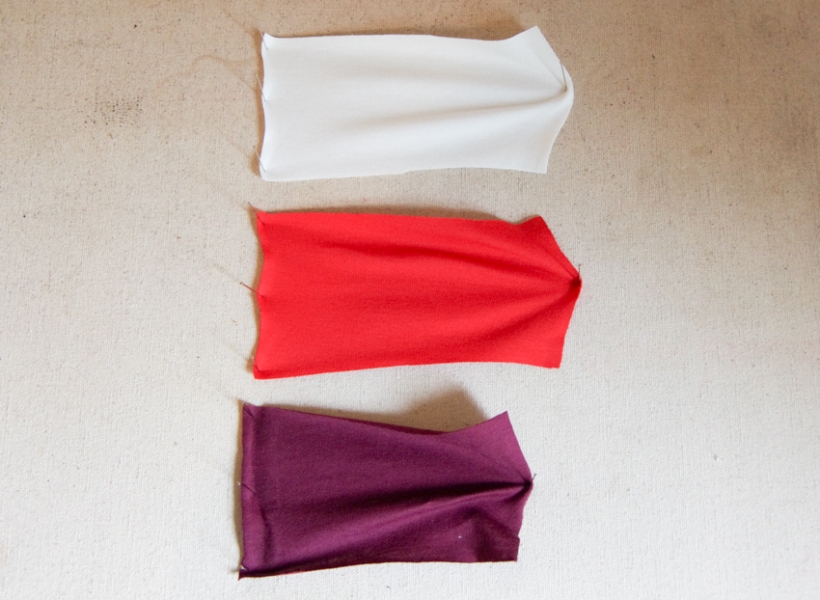
I have stretched each fabric as far as it will stretch without becoming misshapen. None of them are able to stretch very far but I was surprised that the cotton/bamboo jersey stretched farther than the interlock! The cotton jersey stretched least of all and bounced back to its original shape the slowest of the three fabrics.
Do I need ribbing?
As you may be able to tell in the photos of store bought t-shirts at the top of this post, most modern t-shirts do not feature heavy ribbing at the neck band. 1X1 ribbing is the most common choice for modern t-shirt neck bands. 2X1 ribbing used to be a fairly common choice for men’s t-shirts in the past (these “Ringer Tees” would often feature ribbing at the sleeve hem as well) but this is no longer the case. In fact, I have recently been noticing store bought men’s t-shirts with self neck binding rather than ribbing!
The advantage of using ribbing to bind a t-shirt neckline is that your neckline will not be prone to stretching out. Ribbed knits spring back into their original shape very quickly. If you can’t find matching or contrast ribbing, test your fabric’s shape retention abilities by stretching it considerably and then releasing it. Does it revert to it’s original shape or does it look a bit saggy and stretched out? If your fabric contains a small percentage of spandex, you will easily be able to skip purchasing ribbing because the spandex performs the same job as the rib knit. If you are using a 100% Cotton knit that is quite crisp, you may find it keeps it’s shape tolerably well. If you are using a blended jersey with considerable drape, you will likely find that the fabric is prone to dragging and drooping once it is stretched – you can combat this by cutting your neck band shorter or by finding a ribbing fabric for your neck band.
Can I use prints?
When deciding on a fabric choice, you might be tempted to use crazy prints. While many menswear enthusiasts will urge you away from all-over prints…I say go for it! Here are my reasons why:
- It is next to impossible to find a border style print that you can position just over the chest of the shirt to simulate the appearance of your average graphic tee – believe me, I’ve tried! If you don’t feel like getting crafty with fabric paint, spray paint or screen printing, an all over print might be your only choice.
- It is fun to push boundaries while sewing! A t-shirt doesn’t take much fabric or time to create so this is the perfect canvas for edgy print choices. If the recipient is overwhelmed by the print, the t-shirt can easily be made into a tunic dress or a women’s t-shirt instead (speaking from experience here :P).
- All over prints are becoming increasingly common in menswear. Here is my favorite example from Canadian company Frank & Oak. I like the idea of adding a solid pocket to the t-shirt to break up the print:
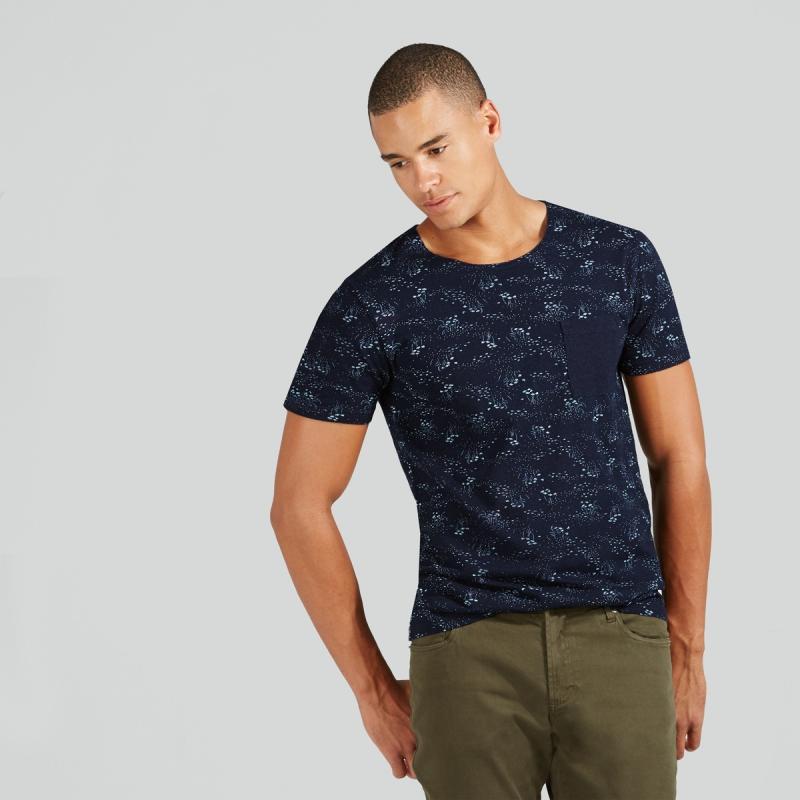
Where to shop:
Since fabric stores are most often geared towards women’s fashion, children’s garments or quilting, it can be a little bit disheartening to sift through the knit section. I often find myself grumpily pushing aside licensed cartoon French Terry, silky rayon knits, and endless bolts of pastel knits until I am left with only three or four suitable bolts of interlock or jersey to choose from! Luckily, men’s t-shirts can be easily personalized using contrast stitching, contrast neck binding or even a contrast pocket if you are faced with a limited selection of colors or prints at your local fabric store.
If you are very limited at your local fabric shop and would like to find better quality or selection online, here is my tried and true list of online knit fabric shops! Each of these shops is a favorite of mine for a unique reason:
Organic Cotton Plus
The quality and selection of the organic knits in this shop are excellent. You can sort the fabrics so that you are only looking at Interlocks or Jerseys and you can even sort so that you are choosing fabrics made within the US! The solid colors available are generally quite earthy and manly but there is also a growing selection of intriguing geometric prints.
Simplifi Fabric
If you are in Canada, you might feel extra limited in regards to knit choices due to the current exchange rates – ordering internationally just doesn’t make sense right now! Fortunately, there is no need to look outside of Canada because Simplifi (based in Ontario) carries eco-friendly textiles of high quality. Their knits section is quite large but you will have to sift through a large amount of prints designed for children’s garments (which are SUPER cute!). If you sort by fibre, you will find that they have a great base of solid knits including a comprehensive selection of bamboo knits – my favorite!
Girl Charlee
If you are looking for a huge selection of fun all-over prints, this is the place to look! You might want to order swatches since Girl Charlee carries such a huge range of knit styles – it can be difficult to tell how drapey, stretchy, heavy, or good quality they are based on the descriptions alone. Matt finds some of the Jersey Blend fabrics are just as comfortable and light weight and easy to wash (no wrinkles) as his favorite H&M t-shirts.
Gorgeous Fabrics
This is an excellent shop to peruse if you are hoping to create a high end t-shirt in an unusual material. There are some beautiful heathered jerseys and even some merino wool knits. Some of the knits are labelled “Tee-shirt weight” which is useful for our purposes! By the way – knits are 20% off right now! And there are some REALLY beautiful Italian sweater knits in stock; I am super tempted to make another Newcastle Cardigan!
Spoonflower
Aside from being able to design your own printed fabric at Spoonflower, you can also peruse the huge library of other people’s designs. Spoonflower can print on an Organic Cotton Interlock knit which would likely be very suitable for a t-shirt and also on a jersey. I haven’t ordered the swatch pack myself so don’t rely on my suggestions about which fabric type to print on! It is probably best to order a sample pack for yourself :).
I hope you are able to find the perfect knits for your sew-along Strath Tee! Make sure to use #strathtee when sharing your t-shirt progress.

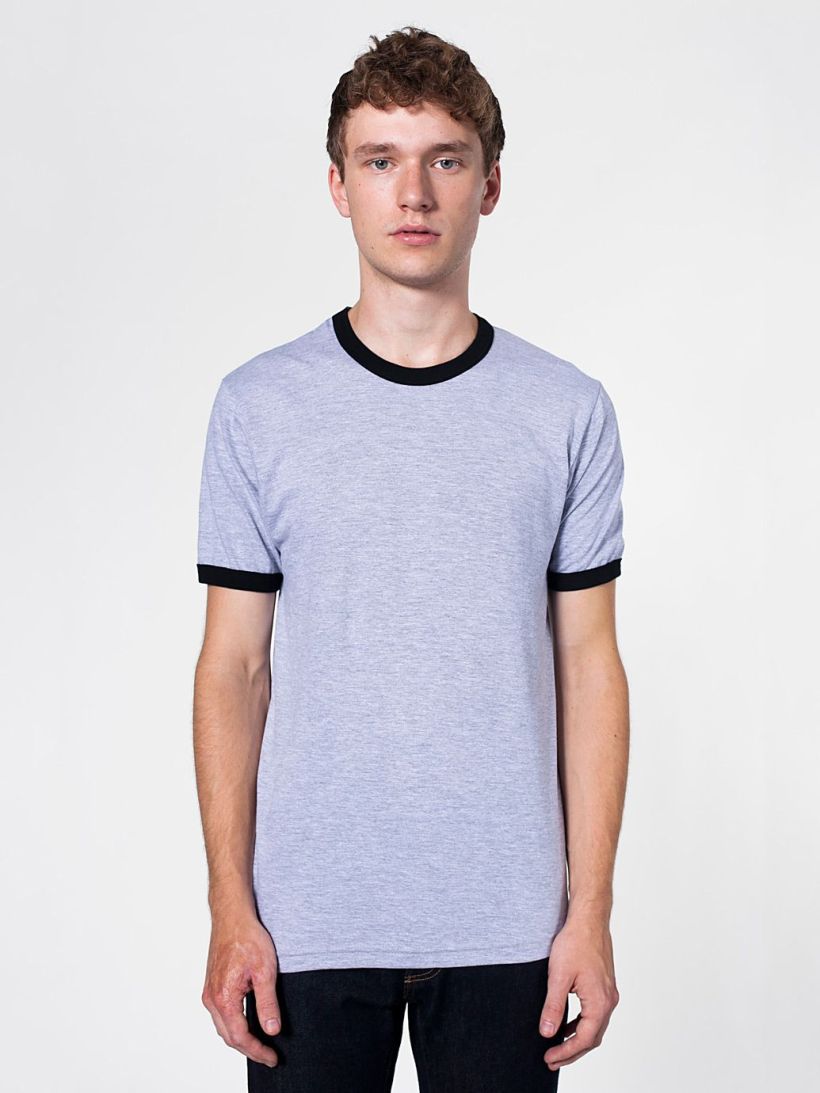
April 17, 2019 at 4:38 am
I found Spiritex Organic Cotton Fabric to be the ABSOLUTE best for t shirt fabric, sweatshirt fabric, and pretty much any other organic and sustainable knit you need.They make everything within 150 miles of their Asheville headquarters with the organic cotton coming from Texas. From my understanding they wholesale their fabric to a few folks listed above so you might even be getting straight to the source by going through them. Prices are extremely reasonable, considering every part of the manufacturing process occurs in the USA. They also have a lot more colors to choose from than anyone else I’ve seen online.
December 17, 2018 at 6:31 am
Amazing information. Probably, one could refer to this as a guide to get the t-shirt fabric. As rightly said in this post, most garments keep women and kid’s fashion in mind. Thank you for sharing the very helpful information.
October 4, 2018 at 3:55 am
Great article, hoping for more articles about fashion style. Thank you so much for the updated information.
January 29, 2018 at 8:07 pm
Hi …I have many graphics design T-Shirt
you can see those here– https://teespring.com/stores/teespring-247
December 24, 2017 at 6:12 am
Superb….
September 15, 2017 at 11:50 am
Thank you for all info, it helps. Can I ask a question please? I had some men’s linen shirts, I liked the feel, the look and the weight etc, just didn’t enjoy the crumpled up look. I’ve been doing some homework but can’t find the answer to a couple of questions I have. I’ve looked at tencel material, seems perfect for heat. Yarn count and weight is troubling me.. Which yarn count 21 21s, 30 30s or 60 60s would be best and what weight, it seems to come in 79gsm, 139gsm, 200gsm? Would I be right in assuming 200gsm is better, not see through. Want one shirt in black and one in white. http://www.ginifab.com/feeds/ozyd2_gm2/
September 15, 2017 at 12:59 pm
Interesting question! In my experience, Tencel also wrinkles quite a lot – almost as much as linen. If you still want to find some linen suitable for shirting, I would recommend the Tencels at Blackbird Fabrics http://www.blackbirdfabrics.com/tencel/ They are beautiful! Of course, they would be suitable for a woven top (such as a button-up shirt) and not for a t-shirt since they have no stretch. The 175gsm in the Blackbird shop is completely opaque and would be a nice weight for a shirt but perhaps heavier than the linen shirts that you are mentioning. If you are looking for a lighter shirt that is cool like linen, hemp/cotton blends are an excellent option! You can find both knits and wovens in our shop, all of them are suitably opaque for men’s shirts – both t-shirts and button-ups: https://threadtheory.ca/collections/sewing-fabrics
September 8, 2017 at 3:52 pm
Hi, thank you for the great information. If you can help me with my delima. What type of fabric or fabric mix that will not fade or discolor easily?. I am in current search for a tshirt fabric or fabric mix that will not worn out easily or fade easily esp. The white and black color. Thank you so much
Pingback: How to make the best T- shirt with Create Fashion Brand Factory
July 15, 2017 at 9:42 am
Hello. Great article! I’m actually in the process of ordering baseball 3/4 sleeve shirts and having them silk screened print my design in the front. I have no idea what fabric I should go with. Since I’m from the New England area I would like something that’s not too thin and has a good shape. Any recommendations would be greatly appreciated! Thank you 🙂
July 17, 2017 at 1:34 pm
I’m not sure what fabrics you have available to you when you place your order but if you are looking for something fairly thick and comfy, try interlock knits – they are double layered knits so they are a bit thicker and more plush than a simple jersey. Or, if you choose a jersey, pick one that is 4.75 oz/sq yard or more to ensure that it isn’t too thin. You can check out all of the knit fabrics that we have in our shop to get an idea for fabric types by reading the descriptions: https://threadtheory.ca/collections/sewing-fabrics/Knits Good luck!
July 17, 2017 at 2:14 pm
Lightweight is the key. Not sure thick goes with that. I decided to use a 65/35 cotton/poly blend
June 24, 2017 at 11:48 pm
I get 100% carded pima cotton t-shirts from Sugini factory in Thailand. The fabric goes through a process called carbonisation, which reduces the hairs on the fabric and leaves the actual fabric soft and more breathable. I would recommend 150 gsm for summer time wear. I also manufacture 100% pima cotton Super soft fabric from Sugini for t-shirts, this goes through a brushing technique that leaves the tiny hairs on the fabric super soft and extra breathable, i usually use this fabric for winter orders using 190 gsm. As far as i’m aware Thailand produces fabric for all the major brands around the world, hence the abundance of new technology machinery with new techniques to produce premium quality fabric. As for the unit costs or yardage costs, you will find Thailand half the price of usual costs as you are going direct to Sugini factory. You can contact Sugini factory via their website: http://www.sugini.com
June 1, 2017 at 6:38 pm
Hi! I have a number of 100% cotton T-shirts, and I’m currently trying to figure out how some of my favorites are made. Basically what type of cotton (they all are listed 100% cotton), what type of stitching, and well…..anything else I’m not sure of. I really like the soft.super soft Tshirts, that tend to have a fair amount of flexibility, but also don’t stretch out early. They all seem to be lightweight (typically lighter than an average white hanes T you’d buy in a package for example) I’m actually trying to figure out a way to recreate my favorite T’s to produce in another country for tourist goods, but I’m still a novice about fabric types.
June 7, 2017 at 5:24 pm
That’s wonderful that you are taking the time to inspect your store bought garments! I always recommend this as a great way to learn about clothing construction and appreciate the manufacturing process. You might like to read this article about knit fabrics – it will give you a very solid foundation! http://www.threadsmagazine.com/item/4160/know-your-knits/page/all Make sure to follow the link at the end of the article to see the photographs of various knit styles as these will probably help you out while analysing your shirts.
June 8, 2017 at 11:25 am
Sadly…..i really have no idea what im looking at. What makes different 100% cotton shirts have different feels and elasticity? What questions can i ask a manufacturer to understand wherher or not what fabric he has will give me the outcome that i want?
June 8, 2017 at 11:49 am
As the article describes, the main factor that can influence the feel and stretch of a knit is the type of stitch used – a knit stitch, purl stitch, tuck stitch or missed stitch (or often a combination of two or more of these). The link at the end of the article with photos of various knit styles describes the properties that each style usually has. For instance, jersey fabric which is a single layer of plain knit stitch is generally more thin and stable (meaning it does not stretch much) while a ribbed fabric such as an interlock features alternating knit and purl stitches which make it stretchier. And interlock is two layers of ribbed fabric making it thick, plush and stretchy (propbably similar to a Hanes t-shirt). I would suspect that the style of fabric that you like is a jersey since it is thin and fairly stable (which makes it not likely to stretch out in my experience). I tend to prefer jerseys for men’s t-shirts myself. I believe jersey is used by many of the fashionable t-shirt designers currently. Here is an example of a jersey t-shirt: https://shop.threadinternational.com/collections/t-shirts/products/first-mile-tee-steeple-grey If you proceed with manufacturing t-shirts, definitely request that fabric samples be sent to you before the process begins!
June 8, 2017 at 1:36 pm
Well…..i have multiple types of soft, thin, tshirts that dont wear or feel all that similar to a regular hanes tshirt. I even have 3 different types of hanes white plain tshirts that have different thickness and wear properties. So they cant all just be jersey based on your descriptions, or there is a difference in the type or processing of the cotton itself, using the same technique, right? Ive been led to believe from suppliers that the type of cotton used or the processing of the cotton (polishing, combing) makes a significant difference in the feel. Maybe thats wrong….hence why im asking someone with more experience than myself.
June 8, 2017 at 2:16 pm
I would suspect that is correct but I do not have training or much experience in fabric manufacturing (one short course in design school during which we analyzed fabric samples and basically learned the same information as presented in the Threads article) so I suppose I am not the best person to ask! This blog post and my experience are from the perspective of a home sewer choosing fabric for themselves by reading descriptions in online fabric shops or feeling fabrics in a fabric store rather than selecting fabric for manufacturing purposes. I’m sorry I can’t be of more help to you other than try to direct you to more knowledgeable sources!
May 31, 2017 at 2:24 am
Great Post. Could you recommend a cotton blend t-shirt percentage that would work for an outdoor / beach t-shirt. what would the percentage be for an optimal fit, look. Also would like effect the size, for example i would like to use this material based on a regular US sizing.
June 7, 2017 at 5:13 pm
Hi Chris,
Interesting question! I think it really depends on personal preference and what blend you are aiming to use! If you are looking to use a cotton/poly blend I notice many storebought shirts feature about 55% cotton and 45% poly but it certainly depends on the brand. I tend to choose t-shirt fabrics with less than 6% spandex for men since spandex adds weight and drape (so it will cling to the body more). There are all sorts of other blends available too! A cotton blended with linen or hemp would be very comfortable for the beach since they breath well and are light weight. We have a few t-shirt fabric options in our shop ranging from 100% cotton to a bamboo, cotton and spandex blend. You might like to check them out: https://threadtheory.ca/collections/sewing-fabrics/Knits If you pre-wash/shrink your fabric your fabric choice will not effect the size. I hope that helps!
March 25, 2017 at 12:17 pm
Great article. I prefer t-shirt with Spandex
March 2, 2017 at 7:38 pm
Hi, would you know the type of cotton knit used for vineyard vine or southern tide long sleeve t shirts? Seems to be heavy matte type of t shirt fabric. Would love to know. Thanks!
March 3, 2017 at 9:50 am
Hi Bren,
I haven’t seen either of these brands in person but after having a look at the photos on both their websites it looks like the tees are made out of an interlock jersey (double knit fabric) rather than a single knit jersey – do they feel a bit spongey and plush? Your description of “heavy” and “matte” reminds me of the interlock that we stock in our shop. I am not certain though!
August 29, 2016 at 7:42 pm
What kind of material do I need for a t-shirt that hugs the body. I wear a popular brand t-shirt that hugs my chest for the first day, then begins to expand and gives me the chills, very uncomfortable.y Help is appreciated. Alan
August 30, 2016 at 2:26 pm
I would recommend a jersey or interlock with at least 4% Spandex. The spandex will ensure that the fabric retains its stretch and does not bag out! Keep in mind that spandex will degrade if washed in a hot drier often so if you want your fabric to last, a t-shirt with spandex in it should be hung or laid flat to dry.
August 11, 2016 at 6:50 am
I am trying to figure out what fabric athletic jerseys were made of in the past, before synthetic fabrics were added. When I was in college in the early 80s, every shirt I bought from a custom t-shirt shop (the kind that sewed or printed logos onto shirts) was cotton and rugged, feeling more like what I expected from a rugby shirt. It’s not quite canvas, but verging on it. I’ve been investigating rugby shirts and apparently all modern rugby shirts are a blend- great for rugby, not what I want for casual use, though.
This material had the remarkable quality of feeling cooler on the skin, even though it’s not as breathable as synthetics- one of the reasons why the rise of high-tech cooling fabrics confused me, because in the old days I didn’t think it was a problem! I’d appreciate any leads.
August 16, 2016 at 12:46 pm
Hi Michael! Interesting dilemma! I’ve looked through my books on textiles and perused Google and am not sure I’ve come up with the correct answer. My first thought was that they may have been made from cotton pique like the classic polo shirt but this doesn’t seem to be the case. I think it is more likely that traditional rugby shirts were sewn from rung spun cotton knits or a heavy jersey. I had a look at Ralph Lauren Rugby shirts and notice that they currently sell one made from a 100% cotton mesh (whatever that might be!): http://www.ralphlauren.com/product/index.jsp?productId=84775226&origkw=rugby&sr=1&kw=rugby&parentPage=search
Anyways, sorry I can’t definitively answer your question. Good luck in your search for the perfect fabric!
July 31, 2016 at 11:24 am
Bamboo is best of all. Why I love bamboo:
1. I can wear a shirt three days before some odor exists. Cotton 1 day. Polyester 4 hours
2. Lasts a very long time.
3. Comfort is amazing
4. Warm in winter, yet hot weather comfortable
5. No iron, looks great
Disadvantage:
1. Costs more than short fiber cotton
2. Longer dryer times
3. Until recently, no prints
4. Have to hunt for bamboo clothing
August 5, 2016 at 8:02 am
Nice summary about one of my favorite fibres! Thanks!
May 10, 2016 at 9:38 pm
excellent post
September 20, 2015 at 7:59 pm
Wonderful post and timely as I’ve just ‘perfected’ a set in sleeve draft for #1 son. Found terrific navy blue with whales 100% cotton knit at Spotlight (Aus). My hubby thought it looked like something you’d make kids pyjamas from and that’s why I love my son – he gets the vision!!
September 20, 2015 at 3:57 am
Good info! A couple of ( late) Canadian sources for T-shirt fabric. Bramakers supply in Hamilton Ont. carries a nice weight (no nipples) 96% cotton with 4% Lycra. The Tees I have made for R are the first out of the closet, have maintained shape and good colour through many washings. They also carry Model I want to try Comox Trunks in ( think Saxx ) PeakFabric in Calgary is a good choice for technical fabrics, PT Power Stretch, Supplex Lycra, etc along with cottons and much more. I find Canadian sources on the expensive side but when I factor in “cost per wear” the quality is there plus with the current exchange rate it is a good time to shop ( relatively) local.
September 21, 2015 at 6:45 pm
Great sources and information! I have wondered about PeakFabric since I often have it come up in my searches but haven’t yet ordered from there. I am gearing up to make an order from Siltex soon – they are the only knit manufacturer in Canada and make high quality interlocks :).
September 19, 2015 at 7:48 am
Now I see why I am more comfortable in my husband’s tees than in any of mine bought from women’s lines—I don’t want drapey stuff clinging to my body. I like the feel of the tee shirts as we wore them when we were kids and very young adults. Thank you!
September 18, 2015 at 12:27 am
This is such a useful post! I think I am a fairly experienced sewer / sewist(?) but often struggle with patterns that want “a medium weight knit fabric” or similar, because that means so many things! This also got me thinking that I probably want different qualities in a fabric for a knit top for a woman (perhaps more drapey?) than for a man. Might be obvious but I actually hadn’t considered that before…!
September 18, 2015 at 9:14 am
Isn’t it interesting how certain factors to consider slip by us? I am often tripped up by drape even though I try to keep it in mind. It is a good idea to hold the fabric up against the body if possible to allow it to drape as it will in the finished garment. It’s pretty difficult to tell if a fabric drapes too much just by feeling a small portion of it on the bolt or by reading about it online.
September 17, 2015 at 11:08 am
Thank you, thank you for a very informative post. I like how you match the descriptions with the fabric type and images. Now I understand why some of my knit makes didn’t turn out so hot.
Speaking of hot, nice eye candy too!
September 18, 2015 at 9:11 am
Grin – I thought, if I were going to be searching for hours for t-shirt photos, I may as well find the attractive ones :D.
September 17, 2015 at 10:30 am
I was in town with my husband for the first time in ages the other day (we have kids!) and we ended up in a menswear dept. He was looking at a t shirt very similar to a Strathcona and I casually mentioned “I have a pattern for a t shirt like that, I could make you one”. He declined as he “likes to choose the image on his t shirt” – he does favour t’s with a picture on the front, but not all of them are and not his ones in that style. Sigh. I think I could get him with the merino though as he’s a cyclist. I noticed that a lot of mens t shirts are textured, i.e. a rib style knit all over, or a waffle effect.
September 18, 2015 at 6:15 am
You could perhaps add a picture of his choice to a t-shirt you made using transfer paper?
September 18, 2015 at 9:15 am
I would like to try transfer paper as I haven’t used it for years! I remember using it in high school to make custom t-shirts but was always unsatisfied with the visible film that it left around the transferred design. I imagine transfer paper has improved considerably since I last used it!
September 18, 2015 at 9:10 am
Good point about textured knits – ribbing can actually be used for the entire garment if the recipient likes the ‘comfortably hugged by fabric’ feel that I find ribbed knits provide. Matt has some ribbed undershirts but the one ribbed Henley I made him doesn’t get worn often because he doesn’t like the casual look and feel that the stretchy and heavy ribbed knit created. It all depends on the man’s preference and the weight of the ribbing I think!
September 18, 2015 at 9:39 am
I had a brief dabble with freezer paper, good for a fairly simple design I think (depending on your cutting skills), I managed some steam punky cogs on trousers for my son (https://prolificprojectstarter.wordpress.com/2015/01/15/boring-trousers/ I think they’d look smarter if I hadn’t put a seperate colour underneath to help the metallics show up). And I like the bleach trees you did in a tutorial somewhere. I want to try thermofax screens sometime (available in the UK http://www.thermofaxscreens.co.uk/) as seen on Marilla’s blog (http://marillawalker.blogspot.co.uk/2015/04/low-tech-printing.html)
Mainly though, he’s a pig to get clothes for, as he wears the same things for years then is surprised if they fall apart, forgets to buy new things for long periods but resents other people buying him things. Not untypical for a man I think!
September 17, 2015 at 2:36 am
I was thinking that if you wanted that bar of print across the chest, you could appliqué a print or piece a strip where you want it, like people do for color blocking–print blocking! Great tips. I love your posts–they are so thoughtful and informative.
September 18, 2015 at 9:08 am
Those are great ideas! I actually bought myself a screen printing system for just such a purpose but not everyone would want to go to such lengths. I really like the applique idea – I have done something similar with a baby’s onesie in the past but never thought to try this out for menswear!
September 18, 2015 at 9:24 am
If you check out the Alabama Chanin website and/or books, you’ll probably find some good appliqué inspiration. That’s where I got started and where I learned to love sewing knits. Have fun screen printing! I hope we get to see some of that on the blog one day! 🙂
September 16, 2015 at 2:42 pm
This is very interesting thank you very much. I made my husband a Strathcona Henley last year in a wool knit which he loves. This year I have made him the plain t-shirt version in a bamboo cotton knit and the fit is very tight. The difference between the two fabrics is really obvious. Now I need to investigate how to add a gusset to the underarm to give him a bit more room.
September 18, 2015 at 9:06 am
That is interesting to hear! Good luck with your underarm gusset, I really hope it solves the fit problem for you. I would love to hear about the results!
September 16, 2015 at 7:59 am
Thank you for such a comprehensive and informative post! I have been frustrated by the limited local selection and feel inspired to try some online purchases now that I know what to look for.
September 18, 2015 at 9:06 am
Best of luck with your online shopping experience! When in doubt, order swatches or have back up plans for your fabric if it isn’t exactly as you expect. 🙂
September 16, 2015 at 6:12 am
Great post!
Pingback: Strathcona T-shirt Sew-Along | Thread Theory